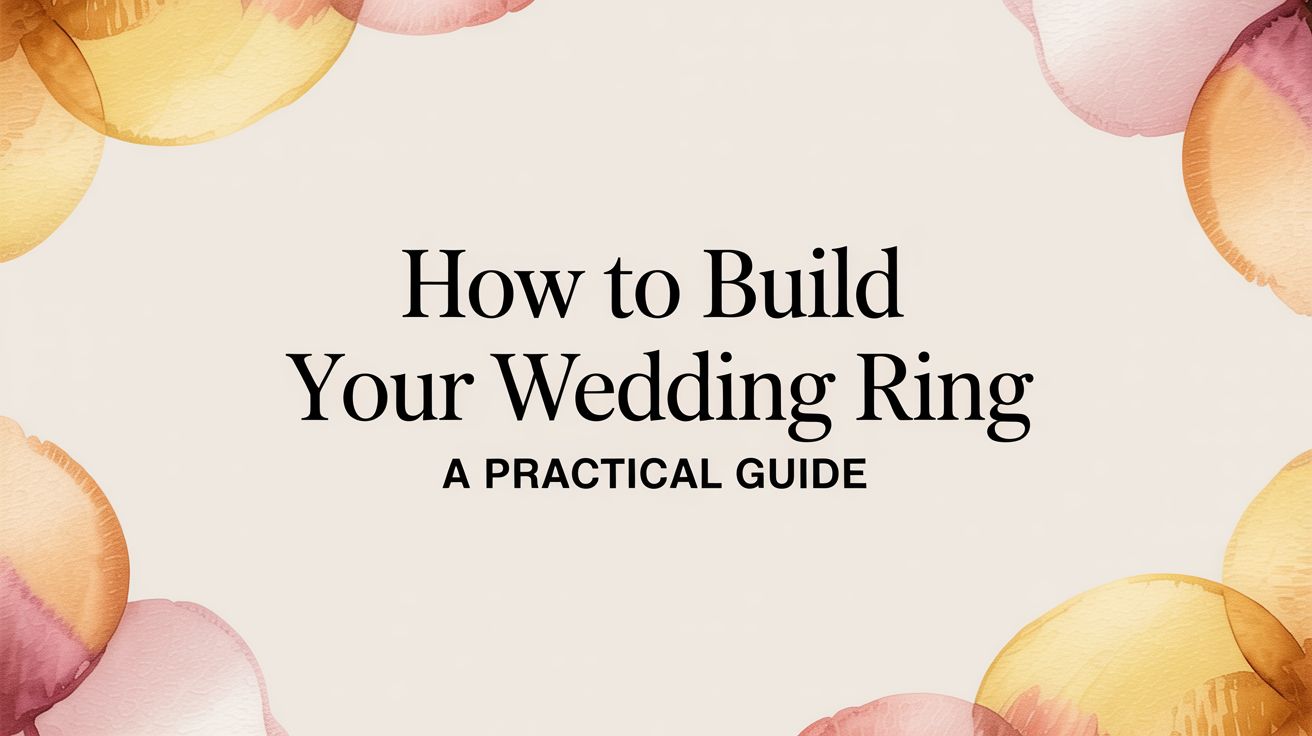Building your own wedding ring isn’t about picking from a catalogue. It’s about commissioning a piece of jewellery that is uniquely, undeniably yours. You step away from the off-the-shelf options to create a symbol that truly captures your story. It’s a surprisingly accessible process that puts you in complete control of the design, materials, and every last detail, guaranteeing a one-of-a-kind heirloom.
Why Create a Custom Wedding Ring
Opting to build your wedding ring is about so much more than just looks; it's an investment in a deeply personal experience. Instead of choosing a pre-made ring from a glass case, you become a core part of its creation. You get to ensure every curve, stone, and finish reflects your personal style and your relationship.
This collaborative journey is also the perfect way to get a flawless fit, especially if it needs to sit alongside an existing engagement ring. Achieving that visual harmony can be tricky with standard bands. Ultimately, you’re not just buying a ring; you’re commissioning a piece of art that tells a story.
Before we dive into the steps, here’s a quick overview of what the custom journey looks like from start to finish.
Custom Wedding Ring Journey At a Glance
| Phase | Key Objective | Typical Duration |
|---|---|---|
| 1. Discovery & Design | Translate your ideas, sketches, and inspiration into a concrete design concept with your jeweller. | 1-2 weeks |
| 2. Material & Stone Selection | Choose the perfect metal (e.g., gold, platinum) and any gemstones, focusing on quality and ethics. | 1 week |
| 3. CAD & Wax Model | Review a 3D digital model (CAD) and/or a physical wax prototype to approve the exact proportions and feel. | 1-2 weeks |
| 4. Casting & Goldsmithing | The ring is cast in your chosen metal and then meticulously shaped, sized, and refined by hand. | 2-3 weeks |
| 5. Stone Setting & Finishing | Gemstones are expertly set, and the ring receives its final polish, texture, and any engravings. | 1 week |
| 6. Final Approval & Delivery | You see the finished piece, give your final approval, and take home your unique, handcrafted ring. | 1 day |
This timeline is a general guide, but it gives you a solid idea of the care and attention that goes into crafting a bespoke piece.
The Rise of Personalised Jewellery
The move towards personalisation isn't just a fleeting trend; it’s a powerful shift, especially in the bridal world. Couples today are looking for authenticity. They want their rings to be as unique as their partnership, telling a story no one else can.
The market reflects this demand. In fact, the UK wedding rings market is projected to hit around $3.587 billion by 2025 and is expected to grow at 7.1% annually. This growth is fuelled by a real consumer desire for skilled craftsmanship and customisation. You can dig deeper into the numbers with this market analysis from Cognitive Market Research.
Key Benefits of a Bespoke Ring
Choosing a custom-built ring gives you several clear advantages over buying off the shelf:
- Unmatched Personalisation: From embedding meaningful symbols to selecting ethically sourced metals and gems, every single element is your call.
- Perfect Harmony: You can design a band that contours flawlessly with your engagement ring, creating a beautiful, unified set that looks like it was always meant to be together.
- Quality and Craftsmanship: When you work directly with a jeweller, you get a level of attention to detail and a commitment to quality that you can literally see and feel.
By building your own wedding ring, you transform a simple purchase into a creative legacy. The process itself becomes a cherished memory, and the final piece is filled with a significance that no mass-produced ring could ever hope to match. It’s a true expression of your commitment, crafted just for you.
Finding Your Inspiration and Design Direction
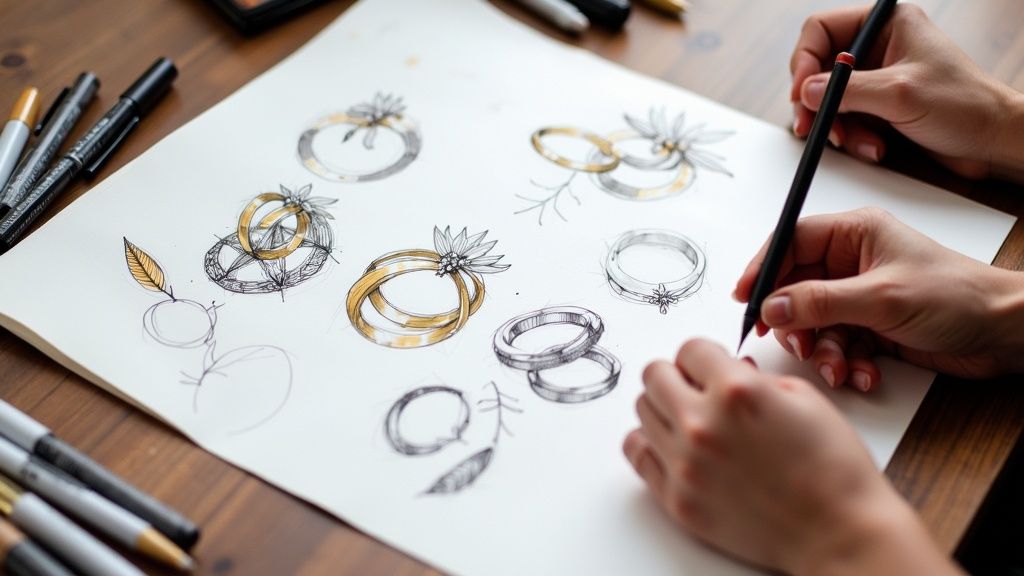
Every truly bespoke wedding ring starts its life not as precious metal, but as an idea. Before we even think about materials and measurements, the first step is to simply look around and gather the things that speak to you.
Don’t just look at other rings. Inspiration can come from anywhere—the clean architectural lines of a building you love, the intricate pattern on a piece of vintage lace, or the organic texture of a seashell. The goal is to collect concepts that feel personal and authentic.
Curating Your Ideas with a Mood Board
A mood board is your best friend at this stage. It’s the perfect way to translate those abstract feelings and scattered ideas into a tangible design brief. It doesn’t need to be fancy; a private Pinterest board or a simple folder of images on your computer works brilliantly.
This collection of images gives us, your jeweller, a direct window into the aesthetic you're drawn to. Start saving pictures that capture a specific mood or style. To get you started, think about broad categories like these:
- Minimalist & Modern: Characterised by clean lines, unadorned bands, and subtle finishes like satin or brushed textures.
- Vintage & Ornate: Think intricate milgrain edging, delicate filigree work, or bold Art Deco geometry.
- Natural & Organic: Often features asymmetrical shapes, hammered surfaces, and designs that mimic forms found in nature.
- Bold & Statement: This could mean a wider band, an unconventional shape, or a striking mix of different metals.
This visual library is far more effective than words alone. It allows you to show, not just tell, us what you envision. And if you’re at the very beginning of your journey, our guide to custom engagement ring designs is full of concepts to spark your imagination.
Collaborating and Ensuring Harmony
While your personal style is the anchor, a wedding ring is ultimately part of a pair. It's so important to chat with your partner about your ideas to land on a direction that feels right for both of you. Your rings don't have to be a perfect match, but they should feel like they belong together.
A great way to achieve this is through a shared element. For instance, one of you might prefer a simple, high-polish band while the other wants a subtle hammered texture. If both rings are crafted from the same 18ct yellow gold, that shared metal creates a beautiful, cohesive link between two otherwise distinct pieces.
Remember, the goal is to create a ring that not only looks beautiful but also feels like a true extension of yourself. Your inspiration is the foundation upon which your jeweller will help you build a meaningful, lasting symbol of your commitment.
Finally, think about the practicalities. How will your new wedding ring sit with your engagement ring? Will they be worn together every day? You might want a perfectly flush "stackable" fit, or perhaps a slight curve is needed to accommodate the setting of your engagement ring's main stone. Considering this now ensures the two rings will form a perfect, harmonious pair for decades to come.
Choosing Your Metals and Gemstones
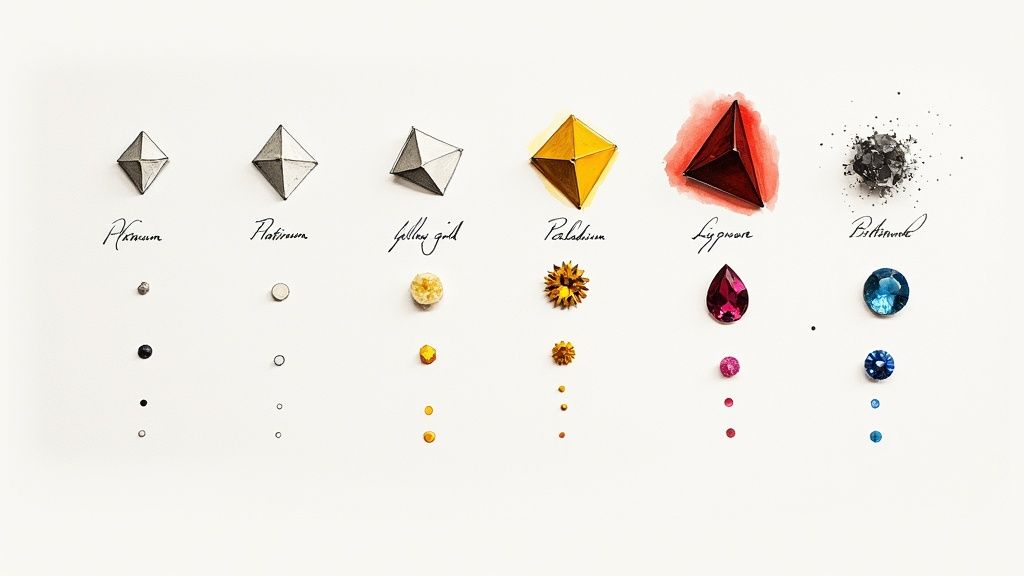
With a clear design direction, it’s time to get hands-on with the materials. This is where the vision starts to feel real. The metals and gemstones you choose will define your ring’s character, its durability, and how it feels to wear every single day. It’s where artistry meets pure practicality.
The foundation of any ring is, of course, the metal. While classic choices are always in style, going bespoke opens up a world of options far beyond the ordinary. Each metal has its own distinct personality, feel, and care requirements.
Selecting the Perfect Precious Metal
Your choice of metal has a huge impact on everything—from the ring’s colour and weight to its longevity. Gold, for instance, remains a massively popular option, which isn't surprising given its heritage and sheer versatility.
In fact, gold still commands a huge 49% of the UK jewellery market share, a testament to its enduring appeal in a market valued at around $5.76 billion in 2024. Rings are the undisputed leader in this space, making up 36.26% of all jewellery revenue. You can dig deeper into these trends in this UK jewellery market report from Grand View Research.
Beyond the classic yellow gold, here are some other fantastic options we work with every day:
- Platinum: A naturally white, dense, and hypoallergenic metal loved for its extreme durability. Over time, it develops a soft, satin-like patina rather than losing metal when scratched.
- White Gold: A beautiful and popular alternative to platinum. It’s an alloy of gold and white metals, typically plated with rhodium for a bright, silvery-white finish that needs re-plating every few years to stay crisp.
- Rose Gold: This warm, pinkish hue comes from alloying pure gold with copper. Its romantic, almost vintage feel has made it a modern favourite.
- Palladium: A platinum-group metal that is lightweight, hypoallergenic, and naturally white, meaning it never needs rhodium plating.
Deciding on the right metal is a balance of aesthetics, lifestyle, and budget. To make it a bit easier, here’s a quick comparison of the most popular choices.
Precious Metal Comparison for Your Wedding Ring
| Metal | Pros | Cons | Typical Price Point |
|---|---|---|---|
| Platinum | Extremely durable, hypoallergenic, naturally white so colour won't fade. Feels substantial. | Denser and more expensive than gold. Scratches can create a 'patina' which some may not prefer. | Premium |
| White Gold | Offers the bright white look of platinum at a more accessible price. A classic, popular choice. | Needs re-plating with rhodium every 1-3 years to maintain its colour. Contains nickel (allergy risk). | Mid-to-High |
| Rose Gold | Unique, warm, and romantic colour. Very durable due to its copper content. Hides scratches well. | Not hypoallergenic for those with copper sensitivities. | Mid-Range |
| Yellow Gold | The traditional, timeless choice. Easy for jewellers to work with and repair. Purest colour of all. | The softest of the golds, so it can be more prone to dents and scratches, especially at 18ct. | Mid-Range |
| Palladium | Lightweight, hypoallergenic, and naturally white like platinum but at a lower price point. | Can be more difficult for some jewellers to resize or repair. | Mid-Range |
Ultimately, the 'best' metal is the one that fits your life and your personal style perfectly.
Adding Meaning with Gemstones
Gemstones can bring a subtle sparkle, a splash of colour, or a deeply personal touch to your ring. You don’t need a massive centre stone to make an impact; even small, thoughtfully placed gems can transform a design.
For example, a delicate pavé setting, where tiny diamonds are set closely together, can create a continuous surface of sparkle. It’s a brilliant way to add life to a minimalist band without overwhelming it.
Another idea is to incorporate a birthstone or a gem that holds personal meaning. A tiny sapphire set on the inner band can serve as a hidden "something blue"—a secret detail just for the two of you.
The real beauty of a custom ring is making choices that reflect your values. Never hesitate to ask about recycled metals or ethically sourced gemstones. These details are what make your ring’s story truly yours.
A Note on Ethical Sourcing
Today, knowing where your materials come from is more important than ever. When you decide to build your wedding ring, you have the power to make responsible choices. Always ask your jeweller about their sourcing practices.
Many artisans, including us, prefer to work with recycled precious metals. They have the exact same quality and purity as newly mined metals but with a much smaller environmental footprint.
For diamonds and other gemstones, options like conflict-free natural stones or stunning lab-grown alternatives ensure your ring is not only beautiful but also ethically sound. This commitment adds a priceless layer of integrity to the finished piece.
Seeing Your Ring Come to Life: The Creation Process
Once we’ve finalised your design and chosen the materials, the really exciting part begins. This is where your ideas leave the page and start their journey into a real, wearable piece of art. It’s a blend of modern tech and age-old craftsmanship.
First, we turn your two-dimensional sketch into a three-dimensional model using Computer-Aided Design (CAD) software. A skilled designer builds a precise digital version of your ring, getting every curve, angle, and measurement spot on.
This digital blueprint is your first chance to see the ring from every angle. We can check proportions, see how it snuggles up against your engagement ring, and make any little tweaks before a single gram of metal is used. It’s a vital approval stage that ensures there are no surprises down the line.
From Digital Design to Physical Prototype
Happy with the CAD renders? Now the magic really starts. We send the digital file to a high-resolution 3D printer, which creates a perfect wax or resin model of your ring. This isn’t just for looking at—it's a physical prototype you can actually hold and try on.
This step is priceless. You get to feel the ring's true size and scale on your finger, confirming the fit and comfort in a way a computer screen just can’t replicate. It’s your final opportunity to make adjustments before we commit to precious metal.
The wax model is the bridge between the digital dream and the final reality. Holding it in your hands for the first time is often the moment couples realise, "This is really happening!" It solidifies the design and builds excitement for the finished piece.
The infographic below shows how quickly a design can move through these early stages, from a digital model to a physical cast.
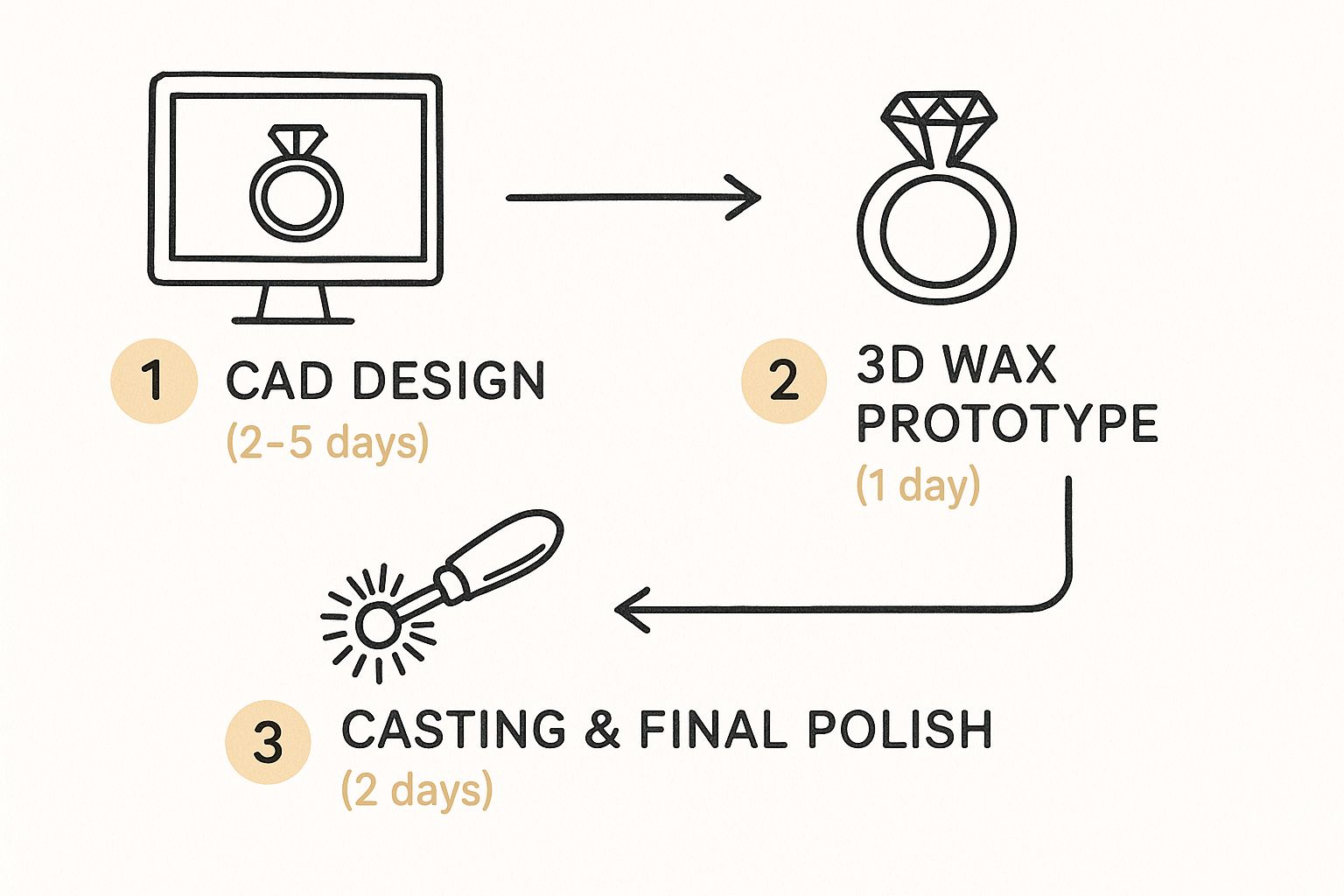
As you can see, we can get from a signed-off design to a cast-ready model in about a week.
The Art of Casting and Finishing
With the wax model approved, it’s time for casting. The wax is set inside a plaster-like mould, which is then fired in a kiln. The wax melts and burns away completely, leaving a perfect, hollow impression of your ring inside. This ancient technique is known as the lost-wax casting method.
We then pour molten metal—your chosen platinum, gold, or palladium—into this mould, where it fills the void and takes the exact shape of your ring. Once it’s cooled, we break the mould away to reveal the raw metal casting. This process is the heart of creating intricate and durable jewellery. You can learn more about the details of our jewellery casting services and how they bring designs to life.
But the raw casting is just the starting point. From here, a master jeweller takes over for the finishing, a series of meticulous tasks done entirely by hand:
- Cleaning and Filing: The rough surface is carefully filed, sanded, and refined to smooth away any tiny imperfections from the casting.
- Stone Setting: If your design includes diamonds or gemstones, they are now expertly set into the metal by hand, ensuring they are perfectly secure.
- Polishing and Finishing: The ring goes through several stages of polishing to achieve its final look, whether that’s a mirror-like shine, a soft satin finish, or a custom texture.
- Engraving and Hallmarking: Finally, any personal engravings are added. The ring is then sent to the Assay Office for official hallmarking to certify its metal purity.
It's this hands-on skill that breathes life and character into the metal, turning a raw casting into the beautiful, finished ring you’ll wear for a lifetime.
Budgeting and Finding the Right Jeweller
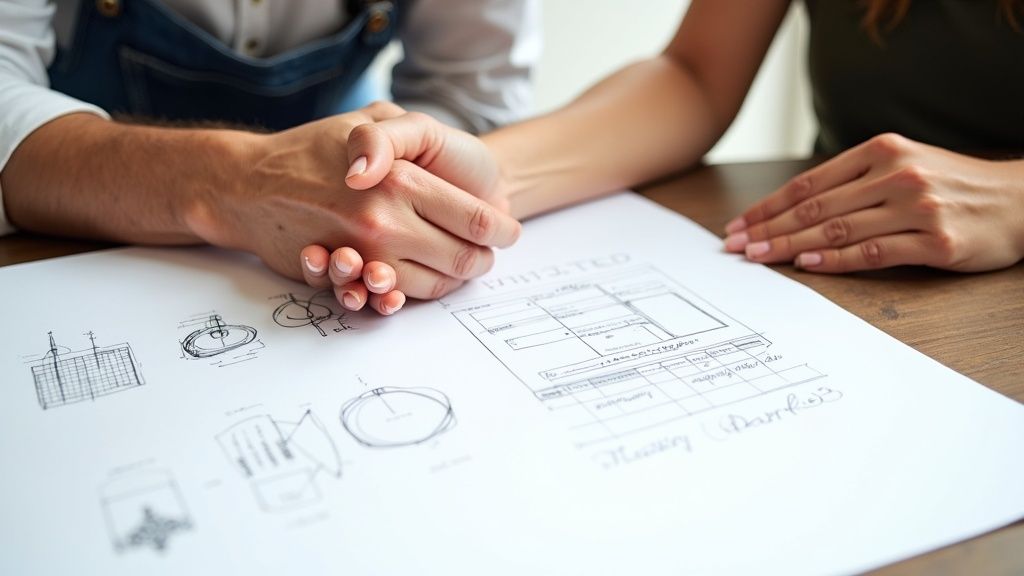
With your design vision taking shape, it’s time to get into the practical side of things: setting a realistic budget and finding the perfect artisan to bring your ring to life. Understanding the costs involved when you build your wedding ring from scratch is key to avoiding surprises and making confident decisions.
The final price of a bespoke ring really comes down to three things: the metal you choose, the type and number of any gemstones, and how complex the design is. A simple, unadorned platinum band is going to be a world away in cost from an intricately engraved ring set with a full circle of pavé diamonds.
It helps to have a rough idea of what people are spending. Research for 2025 suggests the average wedding ring costs around £950, with couples spending roughly £4,000 on their total wedding jewellery. This gives you a decent benchmark as you start planning. You can see more on UK wedding jewellery trends over at Chapter79.co.uk.
How to Find a Trusted Jeweller
Finding the right jeweller isn't just a transaction; it's more like finding a creative partner. You need an expert who not only has the technical skill but also genuinely understands and connects with your vision. A great place to start is by looking for local, independent jewellers with strong, visible portfolios.
Take a good look at their past work. Does their style actually match what you have in mind? Look for consistent quality and a high level of craftsmanship across different pieces. Don’t just rely on the polished photos on their website—dig for genuine client reviews on independent platforms to get a real feel for their customer service.
A jeweller’s portfolio shows their skill, but client testimonials reveal their ability to listen, collaborate, and deliver on a promise. Finding an artisan who excels at both is the key to a successful and enjoyable custom ring experience.
Once you've shortlisted a few candidates, set up an initial consultation. This meeting is your chance to see if you click and to ask the important questions.
Questions for Your First Consultation
Go into that first meeting prepared. A productive chat will leave you feeling confident and understood. Here are a few essential things to ask:
- Can you show me examples of similar work you’ve done? This helps you see their experience with your specific style.
- What is your process for design approvals? You want to know when you'll see things like CAD renders or wax models.
- How do you source your metals and gemstones? This is crucial if ethical sourcing is a priority for you.
- What’s the estimated timeline from start to finish? Make sure their schedule works with your wedding date.
- What happens if a repair is needed down the line? It's smart to understand their aftercare service. For an idea of what that involves, our jewellery repair price list outlines some common services.
Choosing the right person is probably the most important decision you'll make in this whole process. A talented, communicative jeweller will guide you through every stage, turning your ideas into a beautiful, lasting symbol of your partnership.
A Few Common Questions About Building a Wedding Ring
Deciding to build a bespoke wedding ring is a big step, and it’s totally normal to have questions about the practical side of things. How long does it take? Is it going to be more expensive? Knowing the answers helps you move forward with confidence.
Here are a few of the most common queries we hear from couples just starting out.
How Long Does the Custom Process Take?
This is usually the first question on everyone's mind. While every design has its own timeline, a good rule of thumb is to budget between 6 to 12 weeks from your first chat with us to the moment you have the finished ring in hand.
This timeframe gives us plenty of room for a relaxed, thorough process, covering all the crucial stages:
- Initial design talks and sketching out ideas.
- Creating and getting your sign-off on the detailed CAD models.
- Producing a 3D-printed wax prototype for you to try on.
- Casting the ring, setting any stones, and applying the final polish.
To keep things completely stress-free, we always suggest starting the process at least three to four months before your wedding day.
Is Building a Ring More Expensive?
It’s a common myth that bespoke automatically means more expensive. While a complex design dripping with diamonds will of course have a higher price tag, a simple, elegant custom-made band can be surprisingly comparable to a designer ring you'd find in a shop window.
The real beauty when you build your wedding ring is control. You call the shots on the metal, the width of the band, and whether to add gemstones. This lets you steer the design to perfectly match what you want to spend.
A custom ring isn't inherently more expensive; it's simply more personal. You direct the investment into the features that matter most to you, whether that's the satisfying weight of platinum or the quiet detail of hand-engraving.
Can I Use My Own Heirloom Materials?
Absolutely—we love doing this. Using gold from a grandparent's ring or resetting a diamond from a family heirloom is a beautiful way to weave your story into your future. It adds a layer of meaning that you just can't buy off a shelf.
Many independent jewellers, us included, specialise in remodelling existing jewellery. It’s a wonderfully sustainable choice that gives unworn pieces a new life. Just be sure to bring it up in your first consultation so we can assess the materials and work them thoughtfully into the new design.
What if I Dislike the Design Partway Through?
A professional jeweller’s process is built from the ground up to prevent this from ever happening. We have two key checkpoints built in specifically for your approval, making sure you love the design long before it's cast in precious metal.
- The CAD Renders: First, you’ll review a detailed 3D digital model. This lets you see the ring from every possible angle and request any tweaks you'd like.
- The Wax Model: Next, you get to hold and try on a physical prototype. This is your chance to confirm the size, shape, and how it feels on your hand.
Being open and honest at these stages is everything. These approval steps are our guarantee that the final ring is exactly what you were hoping for.
At Opulence Jewellery Services, our master jewellers are here to guide you every step of the way in creating a ring that's truly yours. Start your bespoke journey with us today.
